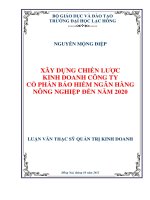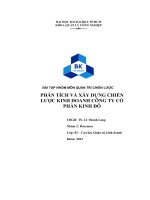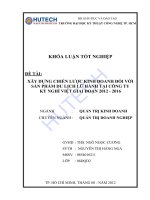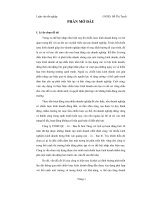XÂY DỰNG CHIẾN lược KINH DOANH CÔNG TY sản XUẤT PHỤ TÙNG ôtô và THIẾT bị CÔNG NGHIỆP JAT GIAI đoạn 2012 – 2020 e
Bạn đang xem bản rút gọn của tài liệu. Xem và tải ngay bản đầy đủ của tài liệu tại đây (947.09 KB, 92 trang )
THESIS
BUSINESS STRATEGY FOR JAT AUTOPART
AND INDUSTRIAL EQUIPMENTS
MANUFACTURING JOINT STOCK COMPANY.
PERIOD 2012 – 2020
.
TABLE OF CONTENT
TABLE OF CONTENT.........................................................................................................................2
INTRODUCTION.................................................................................................................................8
1. Thesis significance.........................................................................................................................8
2. Thesis objectives and applications...............................................................................................9
3. Research methodologies...............................................................................................................9
4. Thesis structure and layout: The thesis is divided into 3 parts as followed..............................10
CHAPTER I.........................................................................................................................................10
THEORETICAL BASIS OF MAKING ENTERPRISE BUSINESS STRATEGIES.......................10
1. Overview of the enterprise development strategy..........................................................................10
1.1 The concept of enterprise strategy..........................................................................................10
1.2 The role of strategy for enterprise.......................................................................................12
1.3 The level of strategic management in the enterprise..........................................................13
1.4 The development strategies of the enterprise....................................................................13
2. Strategic planning of enterprise development...........................................................................15
2.1 Strategic planning process of enterprise development........................................................15
2.2 Strategic planning tools........................................................................................................18
2.3 Principles of choosing strategy..................................................................................................25
2.4. Evaluate the selection strategy............................................................................................29
CHAPTER II........................................................................................................................................31
BUSINESS AND PRODUCTION ANALYSIS OF JAT AUTOPART AND INDUSTRIAL
EQUIPMANT MANUFACTURING JOINT STCOK COMPANY..................................................31
I. GENERAL INTRODUCTION ABOUT JAT AUTOPART AND INDUSTRIAL EQUIPMANT
MANUFACTURING JOINT STCOK COMPANY...........................................................................31
1. Foundation history and development of the company....................................................................31
1.1 Foundation process................................................................................................................31
1.2 Functions and tasks................................................................................................................33
1.3 Mission, vision, philosophy in business................................................................................34
2. Manpower of the company.........................................................................................................37
2.1 Capital resource.....................................................................................................................37
2.3 Human resource.....................................................................................................................38
2.3 Technology............................................................................................................................39
3.1. Investment............................................................................................................................40
3.2 Business and production status.............................................................................................42
II ANALYSIS OF BESIDE FACTORS INFLUENCING THE COMPANY....................................45
1. Macro environment.....................................................................................................................45
1.1 Economic environment..........................................................................................................45
1.2 Legal – politic environment..................................................................................................48
1.3 Social culture environment...................................................................................................49
1.4 Technological environment..................................................................................................50
1.5 natural environments...........................................................................................................50
2. Analysis of industry environment...............................................................................................51
2.1 Analysis of competitive forces from potential rivals............................................................51
2.2 analysis of customer force....................................................................................................52
2.3 Analysis of supplier’s force...................................................................................................53
3. Opportunities and challenge......................................................................................................55
3.1 Opportunities........................................................................................................................55
3.2. Challenges............................................................................................................................56
4. Analysis of competition, matrix model CPM..............................................................................57
4. Matrix model EFE.........................................................................................................................58
III. ANALYSIS OF THE COMPANY INTERNAL SITUATION....................................................60
2. Analysis of supporting activities.................................................................................................67
2.1 Supplier management..........................................................................................................67
2.1 Human resource management.............................................................................................68
2.3 General management............................................................................................................69
3. Analysis, recognition and evaluation of valuable and core capacity..........................................70
5. IFE Matrix.....................................................................................................................................71
IV. SWOT ANALYSIS........................................................................................................................72
CHAPTER III.......................................................................................................................................73
CONCLUSION AND RECOMMENDATION...................................................................................73
I. ENTERPRISE DEVELOPMENT STRATEGY PERIOD 2012-2020...........................................73
1. The strategy targets.....................................................................................................................73
1.1 For the scale and market share.............................................................................................73
1.2 Detailed targets......................................................................................................................73
II. TARGET SUGGESTION...............................................................................................................74
1. TOWS matrix................................................................................................................................74
2 SPACE matrix model......................................................................................................................76
3. Suggestion of strategy selection through QSPM matrix.............................................................78
3.1 QSPM matrix for SO group....................................................................................................78
3.2 QSPM matrix for ST group.....................................................................................................81
3.3 QSPM matrix for WO group...................................................................................................82
3.4 QSPM for WT group...............................................................................................................83
III. SUGGESTION OF STRATEGY IMPLEMENTATION SOLUTIONS......................................85
1. Human resource solution............................................................................................................85
2. Financial solutions.......................................................................................................................87
3. Marketing solutions....................................................................................................................87
4. The research and development solutions .................................................................................88
IV. PROPOSAL TO THE GOVERNMENT......................................................................................88
CONCLUSION....................................................................................................................................90
REFERENCES.....................................................................................................................................91
LIST OF FIGURES
Figure 1-1. Strategic planning of enterprise development diagram..................................................16
Figure 1-2. Diagram of comprehensive strategic management..........................................................18
Figure 1-3. Flow sheet diagram of analyzing strategy formation.......................................................19
Figure 1-4. Model of SWOT matrix....................................................................................................23
Figure 1-5. Model of QSPM matrix...................................................................................................24
Figure 1-6. The main strategic matrix.................................................................................................28
Figure 2-7. Chart of Structure..............................................................................................................35
LIST OF TABLES
INTRODUCTION
1. Thesis significance
Building strategies is a regular work of any enterprises. The determination of
proper strategies decides the target success and the mission of the enterprises.
However, not all the Vietnamese enterprises develop right strategies. Failure of
the enterprises is the evidence for the inadequacy in the strategy. Therefore,
strategy building is always paid special attention with its full significance and
urgency even for the companies with inherent good strategy. In the situation of
Vietnam integration into the world economy, the strategy building is much more
important. Good opportunities come together with bigger challenges. For
competing successfully, the enterprises must determine the right approach, good
strategy based on deep acknowledgement on its strength and weaknesses,
opportunities and risks.
In reality, many enterprises, especially small and medium enterprises pay less
attention to strategies; even they do not build a strategy for their companies. The
primary reason is because these enterprises are not aware of the significance of
strategies.
During the development history, in the sector of automobile and motorbike
manufacture, the immature and slow-developed Vietnam auxiliary industry is the
largest barrier which hinders the development of automobile and motorbike
industry development. One of the reasons for the poor development of auxiliary
industry is that the enterprises do not focus on building the thorough business
strategy. The thesis is written as a necessary mean for building a form of small,
reduced and effective business unit of manufacturing motorbike spare parts,
contributing to pushing the car and motorbike industry development and its
auxiliary industry development.
2. Thesis objectives and applications
-
For theoretical bases:
+ All the subjects studied during the course IeMBA are used in the thesis and
then applied to the practical manufacture and business of the Jat Autopart and
Industrial equipments manufacturing Joint Stock Company in the most effective
way.
-
For the practical usage:
+Help the Jat Autopart and Industrial equipments manufacturing Joint Stock
Company successfully build the highly feasible business strategy for the period
2012-2020.
+Build the Jat Autopart and Industrial equipments manufacturing joint stock
Company to be an auxiliary enterprise which is small, reduced and effective.
+ Create a breakthrough in strategy contributing to pushing up the development
of auxiliary industry in the coming years.
3. Research methodologies
- The main method used for the thesis research is the description stastistic and
the strategic planning matrix ( Internal factor evaluation matrix- IFE, external
factor evaluation matrix -EFE, competition image matrix method, SWOT matrix
and so on). The theoretical base of these matrixes is presented in the chapter 1 of
this paper.
- Information collection:
+ Primary information: collected from the Vietnam Automobile Manufacturers
Association from the Honda Vietnam and the statistical data from the Jat
Autopart and Industrial equipments manufacturing joint stock company will
include audited financial and accounting data.
+ Secondary information: Direct interview with employees of sales department
and manufacture department. Give out survey sheets to customers and suppliers.
Information analysis: Apply statistical techniques to handle, calculate, compare
and assess, then give conclusion for each studies items.
4. Thesis structure and layout: The thesis is divided into 3 parts as followed
Introduction
Chapter I
: Theoretical bases for building the business strategy
Chapter II
: Analyze the current situation of the Jat Autoparts and industrial
equipments manufacture joint stock company.
Chapter III : Conclusion and recommendations
Reference list
Appendix
CHAPTER I
THEORETICAL BASIS
STRATEGIES
OF
MAKING
ENTERPRISE
1. Overview of the enterprise development strategy
1.1 The concept of enterprise strategy
1.1.1 What is strategy?
BUSINESS
Strategy (original word deriving from Greek is strategos) is a military term used
to point out array plan and force distribution with the
goal of defeating the enemy. Carl von Clausewitz –
soldier in 19th century – described the strategy as
“wars planning and warfare campaigns planning”.
Those campaigns will decide the participation of each
individual”. More recently, historian Edward Mead
Earle described strategy as “the art of control and using the resource of a country
or a coalition of nations aim to ensure and increase efficiency for its essential
interests”.
Nowadays, business organizations also apply strategic concept
similar to in the military. The strategy is control plan and using
resource of organizations such as human, assets, finance, etc.
aims to enhance and ensure its essential interests. Kenneth
Andrews was the first person who offered this outstanding
idea in the classic The Concept of Corporate Strategy.
According to him, strategy is which an organization must do based on its strong
points and weak points in the context of opportunities and threats.
Bruce Henderson, strategist and founder of Boston Consulting Group has
connected the concept of strategy with competitive advantage. Competitive
advantage is to put a company in a better position than competitors to create
economic value for customers.
. Henderson said that “Strategy is the careful
search for an action plan to develop and incorporate competitive advantages of
the organization. The difference between you and your competitors are the basis
for your advantage”. Henderson believed that can’t remain two competitors if
they have identical business methods. You need to create the new difference so
you may exist.
Michael Porter also agreed with Henderson: “Competitive
strategy relates to the difference. It is the careful choice of different action
sequence to create a unique set of values”.
Strategy is a plan to give a competitive advantage to the organization over
competitors. A good strategy, implemented effectively, will help the managers
and staff at all levels to determine objectives, identify the line of actions, and
contribute in the success of the organization. In contrast, an organization that has
no clear strategy is like a ship without a boatman.
1.1.2 Concept of enterprise strategy:
There are many different approaches to the concept of strategy. “Business
strategy of a enterprise is an overall action program towards the implementation
of the enterprise goals. The strategy is not to devise specifically how to achieve
these goals because that is the task of innumerable support programs, other
function strategies. Strategy only creates the framework to guide thinking to act.”
[2, 14]. The purpose of strategic planning is to find opportunities and strive to fine
competitive position.
Author Fred R.David, in “Outline of strategic management” defines: “Strategy
is the science and the art of drafting, implementing and evaluating the function
decisions, helping enterprises to achieve the objectives”, “Strategy is the means
to achieve long-term goals. Business strategy may include: expansion of the
operation areas, diversification of activities, property, product development,
market penetration, cutting spending, liquidation and joint ventures” [1, 20].
Recently, a new concept appeared and said that, “Strategy is both a planning process
and is the process of adding new emerged problem”
1.2 The role of strategy for enterprise
- Firstly, the building strategy helps enterprises clear their purposes and
direction in the future.
- Secondly, strategic management process requires specific forecast of
environmental changes, so that managers are able to grasp opportunities
better, and minimize the risks, make business decisions in accordance with
business environment.
- Thirdly, through the strategic management process, the decision of the enterprise
will associate with the environmental changes, helps enterprises maintain and
increase competitive position on the market, in the changing future conditions to
achieve objectives.
- Fourth, good strategic management is a prerequisite to achieve good business
results, increase revenue and profits. However, good strategic management is not a
sufficient condition to success, it only allows to reduce the risks, and increases the
ability to take advantage of opportunities.
1.3 The level of strategic management in the enterprise
Strategic management according to management level in the enterprise is
divided into three parts:
-
Company strategic management (Corporate strategy) with the scope is to
determine the purpose and objectives of the company, determine business
line, determine the core field that company need to focus and determine the
resource distribution method of the enterprise.
-
Strategic business unit (SBU: strategic business unit): Select the product, the
target market for the business unit; determine competitive strategy of
business unit with competitors, etc.
-
Functionary strategic management (functional strategy): is the strategy of the
departments, divisions of the company such as: Marketing, human recourse,
finance, manufacturing, project, etc. are built to implement the strategic
objectives of business unit and company.
1.4 The development strategies of the enterprise
1.4.1 Classification of Strategic management by growth focused objectives
-
Market entry strategy
-
Market development strategy
-
Product development strategy
1.4.2 Classification of strategic management by integration objectives
-
Positive Integration: increase control with distribution activities
-
Reverse Integration: increase control with the supply of the materials
-
Horizontal Integration: acquisition of competitors in the same industry to
grow.
1.4.3 Classification of management strategy by diversification objectives
-
Concentric diversity: further development of new product with the same
production technology ( For example: dairy products of Vinamilk )
-
Horizontal diversity: further development of products which don’t have the
same technology but relating to marketing ( For example: new products such
as cookies, Wall ice-cream of Kinh Do)
-
Mixed diversity: development of completely new products, not related to
technology or marketing.
1.4.4 Other specific strategies
-
Leading strategy by low cost: products or services provided by the enterprise
are completely equivalent in quantity but have lower price than competitors.
-
Creating Strategy of product difference: make the products or services are
different from competitors that customers appreciate over competitors
-
“Skim oil film” strategy likes the smart mobile phone business companies.
-
Strategy of effective relationships with customers: strategy of relationships
with customers must provide something that customers appreciate.
-
Strategy of building efficient distribution network: is a phenomenon in which
the value of a product increases when selling more products, reduce the cost
of distribution.
1.4.5
The outward-oriented strategy: joint ventures, association, outsourcing,
acquisition of merged rival company (M&A), franchise (franchising)
1.4.6 The strategies of narrow business activities of the company rr business unit
such as: minimize the scope of business, cut inefficient products, cut inefficient
staff, remove the inefficient field of business line, focus on inventory reduction,
debt collection; disposal the inefficient SBU.
2. Strategic planning of enterprise development
2.1 Strategic planning process of enterprise development
According to Fred R.David, Strategic planning process divided into 3 stages, with
many activities, such as the following diagram
Strategy formation Strategy implementation Strategy evaluation
Figure 1-1. Strategic planning of enterprise development diagram
Source: Fred R.David (2006), [1, 24]
2.1.1. Strategy formation stage
Strategy formation is the process of analyzing the external environment to
identify opportunities and risks; analyzing the internal environment to identify
strong points, weak points of the enterprise; establishing business missions,
vision, setting long-term goals and choosing between alternative strategies.
Strategy formation stage is also called “strategic planning”. There are many
strategic management techniques allow making and selecting strategies. Some of
these tools are: external factors evaluation matrix (EFE), internal factors evaluation
matrix (IFE), strategic positions and activities matrix evaluation (SPACE), Boston
Consulting Group matrix (BCG), and quantitative strategic planning matrix
(QSPM).
2.1.2. Strategy implementation stage:
Strategy implementation is often called operation stage of strategic management.
The basic operation of strategy implementation is to establish annual goals, adjust
the organizational structure adapt to the chosen strategy, provide the policy guide
the work to achieve the goals, build budget to effectively control financial
expenditures, distribute resources and adjust the encouragement system to
promote the staff to make new goals. Strategy implementation requires discipline,
dedication of each individual. The successful strategy implementation revolves
around managers’ ability to promote employees.
2.1.3. Strategy evaluation:
The final stage of strategic management is strategy evaluation. All strategies are
influenced by factors inside and outside capital often change. Three major
activities of this stage are: (1) review the external and internal factors are basis
for the current strategies, (2) Measure results of the strategy implementation of the
enterprise and functional units, comparing with the goals, (3) implement adjustment
activities. Strategy evaluation is necessary because the current success doesn’t
guarantee future success.
The success always creates new problem, the
organizations which have satisfied thought must pay for by the decline.
Strategic management process can be studied and applied to the use of a model.
The diagram below is the model of comprehensive strategic management model
accepted widely, although it isn’t a magic warn of success, it represents a clear
method of steps of formation, implementation and evaluation of the strategies.
Figure 1-2. Diagram of comprehensive strategic management
Source: Fred R.David (2006), [1, 27]
A change in any major component in the model may require a change in one or all
of the other components. Thus, activities of formation, implementation and
evaluation should be done on a continuous basis.
2.2 Strategic planning tools
There are many tools to plan strategy, as well as there are many kinds of strategic
planning. Hereinafter is the process of forming a general strategy with the
common tools used for almost scales and type of enterprises.
Figure 1-3. Flow sheet diagram of analyzing strategy formation
Source: Fred R.David (2006), [1, 260]
Stage 1: summarize entered the basis information necessary for the strategy
formation. Stage 2: focus on making feasible strategies that can choose by sort,
combining important internal and external elements. Stage 3: is considered as
determination stage, including a technique, quantitative strategic planning
matrix (QSPM). QSPM Matrix indicates the relative attractiveness of the strategy
can be selected and thus provide objective basis for selection of specific
strategies.
All six techniques in strategy formation process require a combination between
intuition and analysis. In order to serve the requirements of research topic, in this
section I would analyze specifically 4 main tools: EFE matrix, IFE matrix,
competitive imagine matrix, SWOT matrix, quantitative strategic planning matrix
(QSPM).
2.2.1. EFE Matrix (External factor evaluation matrix)
EFE matrix allows the strategist to summarize and evaluate PEST information
(polity, economy, culture, society, technology, and in addition there are other
factors such as: demographics, geography, law and competition). There are five
steps in developing an EFE matrix.
Step 1: Make a list of factors that play a decisive role for the success as identified
in the inspection process of external factors; including the total from 10 to 20
factors, consisting of opportunities and threats affecting the enterprise and
business line of this enterprise.
Step 2: Classify the importance from 0.0 (unimportant) to 1.0 (very important) for
each factor. The opportunities usually have higher classification than threats,
though the threats may also have higher classification if it’s especially severe or
threatening nature. The suitable classification level can be determined by
comparing the successful competitors with the unsuccessful competitors by
discussing this factor and achieve the consensus of the group. The total of
classification level assigned to the factors must equal to1.0.
Step 3: Classify from 1 to 4 for each factor determining the success to show the
methods that the current strategy of the enterprise response to these factors, in
which 4 is good response, 3 is above average response, 2 is average response and 1
is little one. These levels are based on the effectiveness of the strategy in the
enterprise. Thus, this classification is based on the enterprise, while the
classification in step 2 is based on the industry.
Step 4: Multiply the importance of each variable with its type to determine the
score of the importance.
Step 5: Plus the total score of the importance for each variable to determine the
total score of importance for each organization.
Regardless of major opportunities and threats included in the external factor
evaluation matrix, the highest total score of importance that an organization can
get is 4.0 and the lowest is 1.0. The average total score of importance is 2.5. The
total score of importance is 4 showing that the organizations are responding very
well to the current opportunities and threats in their environment. The total score of
importance is 1 showing that the proposed strategy doesn’t take advantage of
opportunities or avoid external threats.
2.2.2. IFE Matrix (Internal factor evaluation matrix)
This strategy formation tool summarizes and evaluates the important strengths
and weaknesses of functional business parts, and it also provides the basis for
identifying and evaluating the relationship among these parts. To develop an
IFE matrix, the intuitive comments are necessary, so the formality of the
scientific method must be interpreted to show that this is the most effective
technique. Similar to the EFE matrix, IFE matrix can be developed in five steps.
Excluding IFE matrix has how many factors, the total score of importance can
be classified from the lowest is 1.0 to the highest is 4.0 and the average score is
2.5. The total score of importance is lower than 2.5 showing that the enterprise
has internal weaknesses, and the score is higher than 2.5 showing that the
enterprise has internal strengths. Like EFE matrix, an IFE matrix should have
from 10 to 20 key factors. The number of factors doesn’t effect on the group of
the total score of importance because the total of importance levels always
equals to 1.0.
2.2.3. SWOT matrix
Strengths - weaknesses - opportunities – threats matrix is an important combining
tool can help managers to develop four types of strategies: strategies combining
strengths – opportunities (SO), strategies combining weaknesses – opportunities
(WO), strategies of strengths – threats (ST), and strategies of weaknesses –
threats (WT). The combination of internal and external factors is the most
difficult task of developing a SWOT matrix, it requires good judgment and will
not have the best combination.
8-step process to form the SWOT matrix:
1. List the great opportunities
2. List the major threats
3. List the major strengths of the enterprise.
4. List the major weaknesses of the enterprise.
5. Combining strengths with opportunities to find the SO strategy.
6. Combining weaknesses with opportunities to find the WO strategy.
7. Combining strengths with threats to find the ST strategy.
8. Combining weaknesses with threats to find the WT strategy.
STRENGTHS – S
WEAKNESSES – W
1.
1.
2.
2.
3.
3.
OPPORTUNITIES – O
SO STRATEGIES
WO STRATEGIES
1.
Use strengths to take Overcome weaknesses by
advantage of opportunities taking
advantage
of
opportunities
2.
3.
THREATS – T
ST STRATEGIES
WT STRATEGIES
1.
Use strengths to avoid
Overcome
weaknesses
threats
and avoid threats
2.
3.
Figure 1-4. Model of SWOT matrix
Source: Fred R.David (2006), [1, 267]
2.2.5. Quantitative strategic planning matrix (QSPM)
This matrix is an analytical technique to determine the attractiveness of feasible
strategies can be replaced. It is the third stage of analytical framework for strategy
formation. This technique will show objectively which alternative strategy is the
best. QSPM matrix uses input factors by the analysis in the stage 1and the
combined result of analysis in the stage 2 to determine objectively in the possible
alternative strategies. QSPM matrix is the tool that allows objective evaluation of
the possible alternative strategies, first of all based on the key internal and external
success factors. QSPM matrix requires good intuitive judgment.
POSSIBLE SELECTED STRATEGIES
Classification
Strategy 1
Strategy 3
Major factors
Internal factors
• Management
• Marketing
• Finance/ Accounting
•
Manufacturing/implementin
g
•
Researching
developing
• Information system
External factors
• Economy
and
Strategy 2
• Politic/law/government
• Society/culture/population
• Technique
• Competition
Figure 1-5. Model of QSPM matrix
Source: Fred R.David (2006), [1, 287]
-
Ranking internal factors according to levels: 1,2,3,4 the weakest; weak;
strong, the strongest.
-
Ranking external factors according to levels: 1,2,3,4 responses of the
enterprise poor, average, good, very good.
Above is the basic model of QSPM matrix. The left column of QSPM matrix
includes internal and external factors (stage 1), and the top row consists of
feasible alternative strategies (from stage 2). The left column of QSPM matrix
includes the information obtained directly from EFE matrix and IFE matrix.
Next to the column of major success factors is the column of respective
classification for each factor EFE matrix and IFE matrix.
The top row of QSPM matrix includes feasible alternative strategies derived from
the SWOT matrix, SPACE matrix, BCG matrix, IE matrix and the grand strategic
matrix. These strategic matrices often make the feasible alternative strategies can
replace analogously. However, not every technical strategy is evaluated in QSPM
matrix. Strategists should use good intuitive judgment to choose strategies of
QSPM matrix.
Based on the concepts, QSPM matrix determines the attractiveness of different
strategies by leveraging or improving the key internal and external success factors.
The attractiveness of each strategy in the group of feasible alternative strategies
can be calculated by determining the cumulative effect of each key internal and
external success factor.
2.3 Principles of choosing strategy
The choice of enterprise strategy requires answering 3 questions:
1- Enterprise maintains operations in which field?
2- Enterprise withdraws from which field?
3- Enterprise extends which business forms?
The selection process of overall strategy should take the following steps:
-
(1)- Identify the current business strategy
-
(2)- Control the investment category
-
(3)- Assess business strategy
2.3.1. Identify the current business strategy
The managers must know where the enterprise is operating and the organization is
pursuing which strategy. The current strategy gives us the current strategy basis
which is new and confirmed. There are internal and external factors affect the
selection: (1) the framework and the difference of the enterprise; (2) the general
nature and characteristics of the recent withdrawal of the enterprise; (3) the rates,
basis and trend of recent operations of the enterprise; (4) the current opportunities
to pursue; (5) the position with external threats.
The key internal factors are: (1) the goals of the enterprise; (2) the resource supply
standards and model in the list of investment capital of business units in the
enterprise; (3) the attitudes towards financial risks; (4) focus on research and
development; (5) the functional area strategies.
2.3.2. Analysis of investment portfolio
2.3.2.1. Select the management of the organization to analyze
The managers must determine the level in the organization to analyze the









